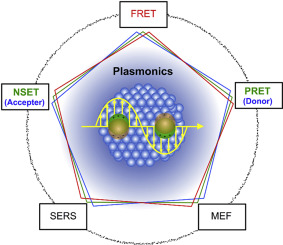Trends in Analytical Chemistry ( IF 13.1 ) Pub Date : 2020-01-08 , DOI: 10.1016/j.trac.2020.115805 Peng Fei Gao , Yuan Fang Li , Cheng Zhi Huang

|
Plasmonic nanoparticles are inextricably linked to the luminescence enhancement and quenching, the main route of which is through energy transfer. Nanometal surface energy transfer (NSET) displays the ability to overcome the fundamental distance limitation (10 nm) of the widely used Förster (or fluorescence) resonance energy transfer (FRET). Besides, the plasmon resonance energy transfer (PRET), another energy transfer plasmonics nanoparticles attended, has become an important optical tools in quantitative analysis and bioimaging in the last decade. Herein, we summarize the analytical applications of both the NSET and PRET technologies. At last, we discuss the opportunities and challenges of these two energy transfer techniques.
中文翻译:

等离子参加的NSET和PRET用于分析应用
等离子体纳米颗粒与发光增强和猝灭有着千丝万缕的联系,其主要途径是通过能量转移。纳米金属表面能量转移(NSET)具有克服广泛使用的Förster(或荧光)共振能量转移(FRET)的基本距离限制(10 nm)的能力。此外,在过去的十年中,另一种参与能量转移的等离激元纳米粒子-等离振子共振能量转移(PRET)已经成为重要的光学工具。在这里,我们总结了NSET和PRET技术的分析应用。最后,我们讨论了这两种能量转移技术的机遇和挑战。



























 京公网安备 11010802027423号
京公网安备 11010802027423号